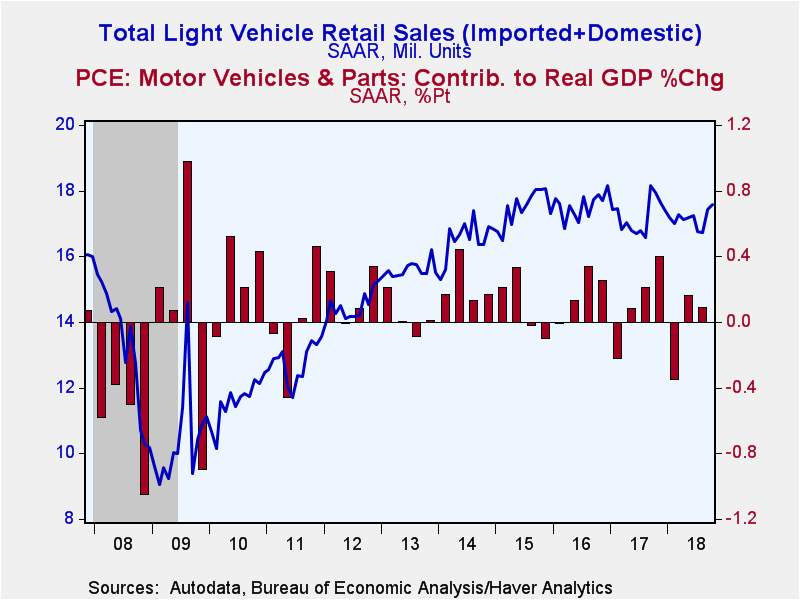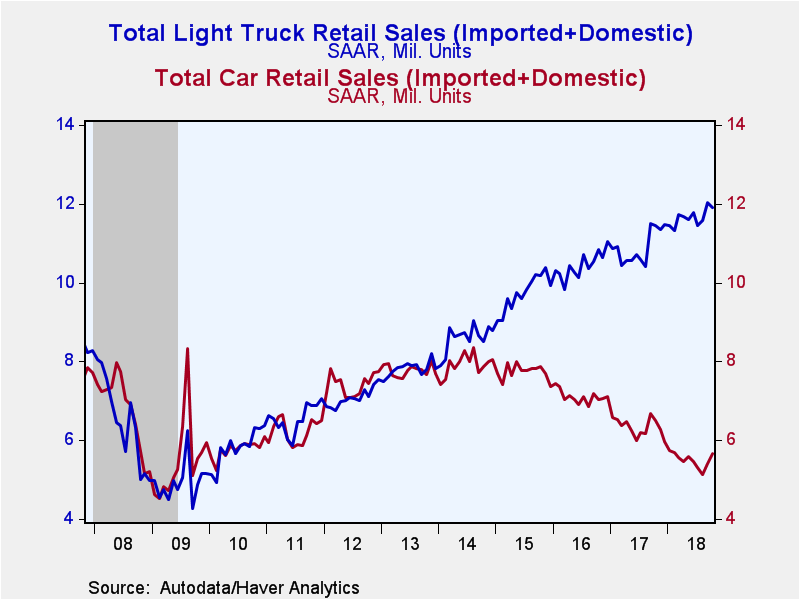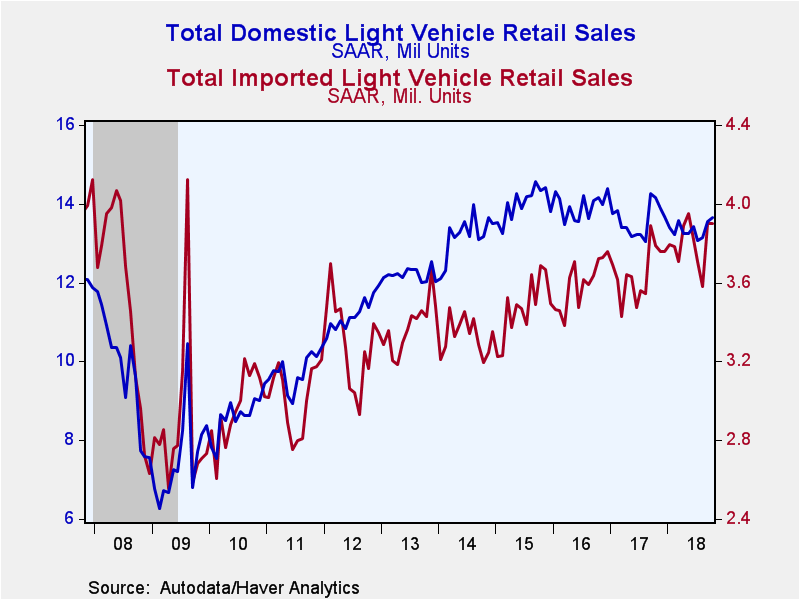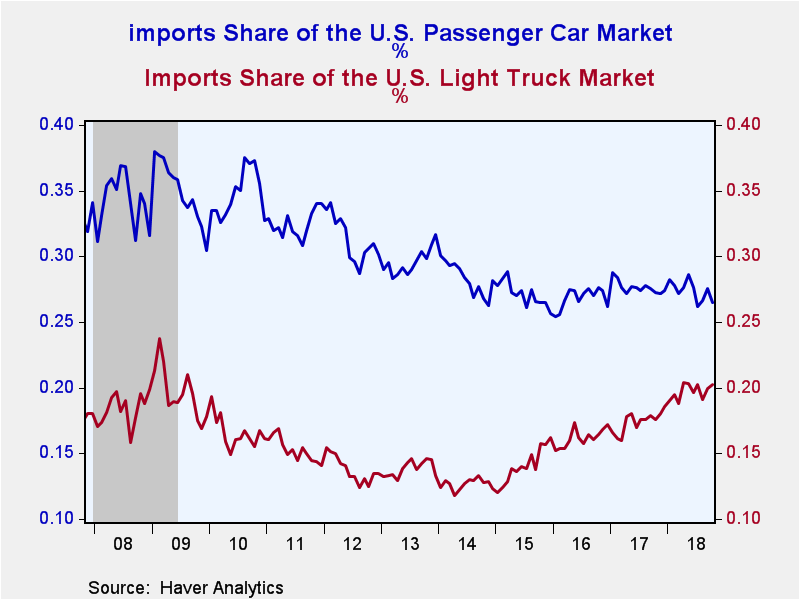 Global| Nov 01 2018
Global| Nov 01 2018U.S. Light Vehicle Sales Improve with Rise in Passenger Car Sales
by:Tom Moeller
|in:Economy in Brief
Summary
Sales of light vehicles increased 0.7% (-2.2% y/y) during October to 17.57 million units (SAAR), the highest level since November 2017. The latest gain followed a 4.3% September jump. Passenger car sales rose 4.8% (-12.8% y/y) last [...]
Sales of light vehicles increased 0.7% (-2.2% y/y) during October to 17.57 million units (SAAR), the highest level since November 2017. The latest gain followed a 4.3% September jump.
Passenger car sales rose 4.8% (-12.8% y/y) last month to 5.67 million units. The rise brought them to the highest level since February. Sales of domestically made cars rose 6.6% (-11.9% y/y) to 4.17 million units and added to a strong September increase. Sales of imported passenger cars rose 0.7% (-15.2% y/y) to 1.50 million units. That gain followed an 8.9% jump during September.
Light truck sales declined 1.1% in October to 11.90 million units. Sales remained up, nevertheless, by 3.9% during the last 12 months. Sales of domestically-produced light trucks fell 1.3% (+0.6% y/y) to 9.50 million units. Sales had been moving steadily upward toward a record high. Sales of imported light trucks improved 0.4% (19.5% y/y) to a new record of 2.41 million units.
Trucks' share of the U.S. vehicle market declined to 67.7% last month, off modestly from August's 69.0% record. This compared to 63.3% during all of last year and 47.3% at the low during all of 2009.
Imports' share of the U.S. vehicle market was little changed last month at 22.2%, but down from 27.6% during all of 2009. Imports' share of the passenger car market fell to 26.5%. Imports share of the light truck market improved to 20.3% which nearly equaled the cycle high. It's up from the low of 12.7% in 2014.
U.S. vehicle sales figures can be found in Haver's USECON database. Additional detail by manufacturer is in the INDUSTRY database.
| Oct | Sep | Aug | Oct Y/Y % | 2017 | 2016 | 2015 | |
|---|---|---|---|---|---|---|---|
| Total | 17.57 | 17.44 | 16.72 | -2.2 | 17.23 | 17.55 | 17.48 |
| Autos | 5.67 | 5.41 | 5.14 | -12.8 | 6.33 | 7.10 | 7.73 |
| Domestic | 4.17 | 3.91 | 3.77 | -11.9 | 4.58 | 5.20 | 5.64 |
| Imported | 1.50 | 1.49 | 1.37 | -15.2 | 1.75 | 1.90 | 2.10 |
| Light Trucks | 11.90 | 12.03 | 11.58 | 3.9 | 10.90 | 10.44 | 9.74 |
| Domestic | 9.50 | 9.63 | 9.37 | 0.6 | 9.00 | 8.75 | 8.37 |
| Imported | 2.41 | 2.40 | 2.21 | 19.5 | 1.90 | 1.69 | 1.38 |
Tom Moeller
AuthorMore in Author Profile »Prior to joining Haver Analytics in 2000, Mr. Moeller worked as the Economist at Chancellor Capital Management from 1985 to 1999. There, he developed comprehensive economic forecasts and interpreted economic data for equity and fixed income portfolio managers. Also at Chancellor, Mr. Moeller worked as an equity analyst and was responsible for researching and rating companies in the economically sensitive automobile and housing industries for investment in Chancellor’s equity portfolio. Prior to joining Chancellor, Mr. Moeller was an Economist at Citibank from 1979 to 1984. He also analyzed pricing behavior in the metals industry for the Council on Wage and Price Stability in Washington, D.C. In 1999, Mr. Moeller received the award for most accurate forecast from the Forecasters' Club of New York. From 1990 to 1992 he was President of the New York Association for Business Economists. Mr. Moeller earned an M.B.A. in Finance from Fordham University, where he graduated in 1987. He holds a Bachelor of Arts in Economics from George Washington University.










